Small overlap front: driver-side
Rating applies to 2015-25 models
Tested vehicle: 2016 Ford Mustang GT 2-door
The Ford Mustang was redesigned for the 2015 model year.
| Evaluation criteria | Rating |
|---|---|
| Structure and safety cage | |
| Driver injury measures | |
| Head/neck | |
| Chest | |
| Hip/thigh | |
| Lower leg/foot | |
|
Driver restraints and dummy kinematics
The dummy’s face remained in contact with the frontal airbag, but its head still rolled around the left side of the steering wheel toward the intruding A-pillar because the seat belt allowed excessive forward excursion of the head and torso. The side curtain airbag deployed and has sufficient forward coverage to protect the head from contact with side structure and outside objects. The side torso airbag also deployed. | |
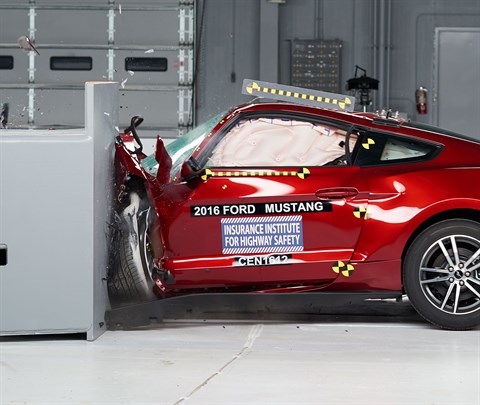
Action shot taken during the small overlap frontal crash test.
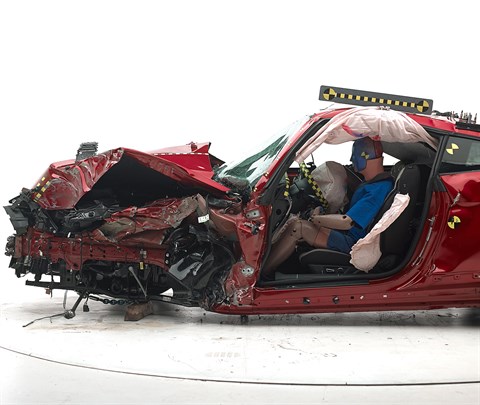
The dummy's position in relation to the door frame, steering wheel, and instrument panel after the crash test indicates that the driver's survival space was not maintained well.
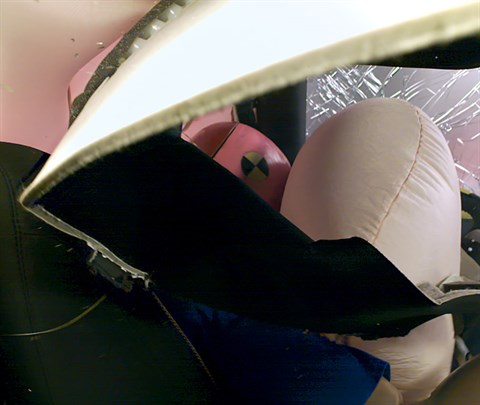
The dummy’s head contacted the frontal airbag but rolled around the left side, allowing the head to approach the intruding A-pillar. (The car's headliner partially blocked the view; it became loose because of camera installation on the roof but did not interfere with the dummy's motion or the side curtain airbag deployment.)
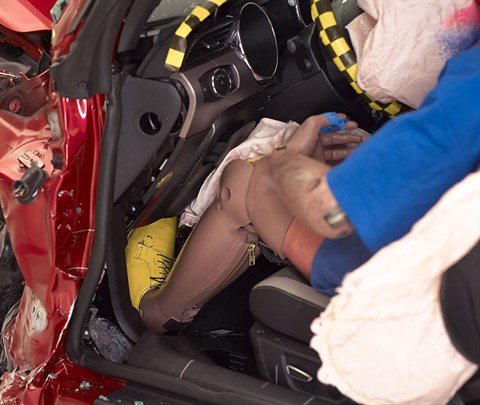
Despite considerable intrusion of the door hinge pillar and instrument panel, risk of injuries to the dummy's legs and feet was low.
Moderate overlap front: original test
Rating applies to 2015-25 models
Tested vehicle: 2015 Ford Mustang GT 2-door
The Ford Mustang was redesigned for the 2015 model year. Moderate overlap frontal ratings are assigned by the Institute based on a test conducted by Ford.
| Evaluation criteria | Rating |
|---|---|
| Overall evaluation | |
| Structure and safety cage | |
| Driver injury measures | |
| Head/neck | |
| Chest | |
| Leg/foot, left | |
| Leg/foot, right | |
| Driver restraints and dummy kinematics | |
Side: original test
Rating applies to 2015-25 models
Tested vehicle: 2016 Ford Mustang GT 2-door
The Ford Mustang was redesigned for the 2015 model year.
| Evaluation criteria | Rating |
|---|---|
| Overall evaluation | |
| Structure and safety cage | |
| Driver injury measures | |
| Head/neck | |
| Torso | |
| Pelvis/leg | |
| Driver head protection | |
| Rear passenger injury measures | |
| Head/neck | |
| Torso | |
| Pelvis/leg | |
| Rear passenger head protection | |
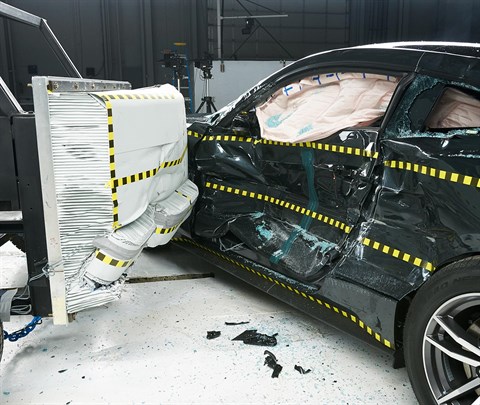
View of the vehicle and barrier just after the crash test.
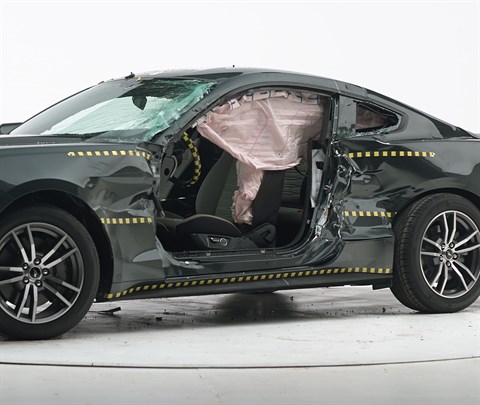
View of the vehicle after the crash with door removed, showing the side airbags and damage to the occupant compartment.
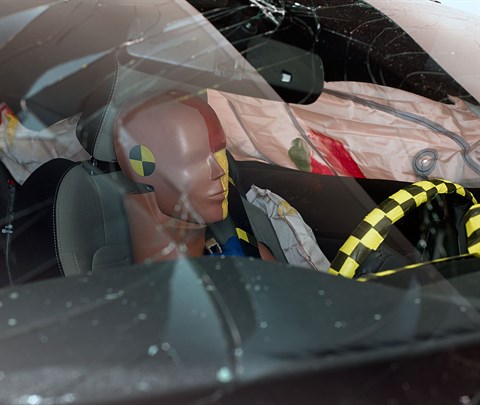
Smeared greasepaint shows where the driver dummy's head was protected from being hit by hard structures by the side airbags.
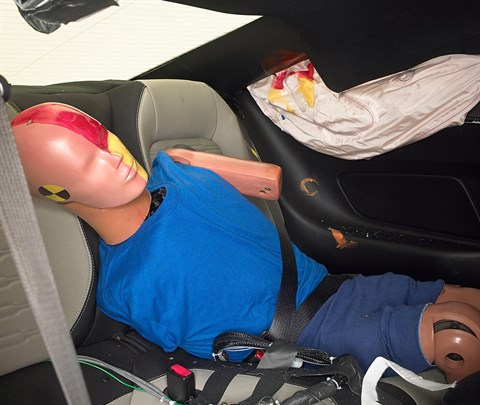
Smeared greasepaint shows where the rear passenger dummy’s head was protected by the side airbag. During rebound, the dummy's head and torso slid out from the shoulder belt and moved across the seat, but this motion does not cause any significant risk of injury.
Roof strength
Rating applies to 2015-23 models
Tested vehicle: 2016 Ford Mustang GT 2-door
| Overall evaluation | |
|---|---|
| Curb weight | 3,696 lbs |
| Peak force | 16,384 lbs |
| Strength-to-weight ratio | 4.43 |
Head restraints & seats
Seat type: Power cloth seat
| Overall evaluation | |
|---|---|
| Dynamic rating | |
| Seat/head restraint geometry |
About the head restraint & seat test
Currently, IIHS tests apply only to front seats.
Front crash prevention: vehicle-to-vehicle
Ratings are given for 2 different trim variations available on this vehicle.
Child seat anchors
Rating applies to 2016-25 models
| Evaluation criteria | Rating |
|---|---|
| Overall evaluation | |
| Vehicle trim | GT |
| Seat type | cloth |
This vehicle has 2 rear seating positions with complete child seat attachment (LATCH) hardware.
| Evaluation criteria | Rating |
|---|---|
| Overall evaluation | |
| Vehicle trim | GT |
| Seat type | cloth |
| Rating icon | Rating |
|---|---|
| G | Good |
| A | Acceptable |
| M | Marginal |
| P | Poor |
| Seating positions that rely on borrowed lower anchors or have only a tether anchor available are not rated. | |
thether anchor symbol | Tether anchor |
lower anchor symbol | Lower anchors |
| Lower anchor(s) can be borrowed from adjacent positions(s) | |
| No hardware available |
Details by seating position
| Position | Rating |
|---|---|
| 1 | |
| Tether anchor | |
| easy-to-find location | |
| no other hardware could be confused for anchor | |
| Lower anchors | |
| too deep in seat | |
| too much force needed to attach | |
| easy to maneuver around anchors | |
| 3 | |
| Tether anchor | |
| easy-to-find location | |
| no other hardware could be confused for anchor | |
| Lower anchors | |
| too deep in seat | |
| too much force needed to attach | |
| easy to maneuver around anchors |
